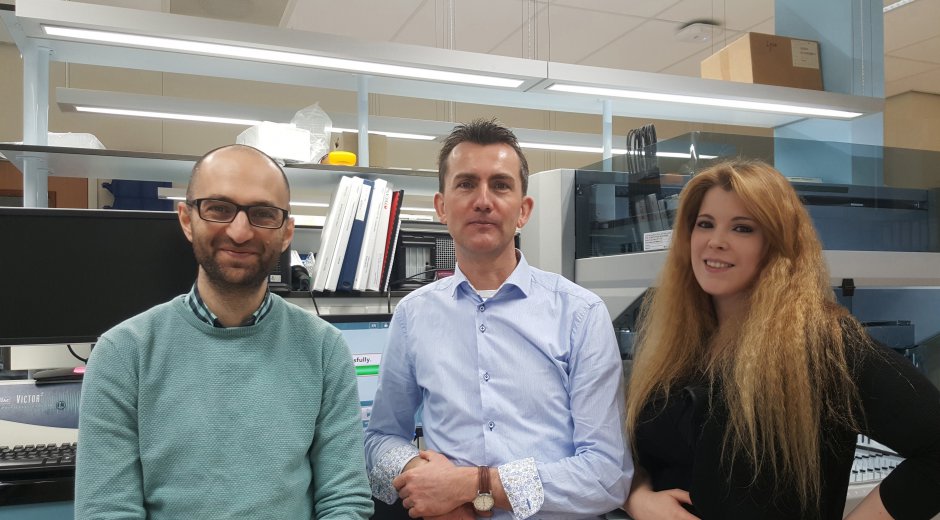
Screening for novel metabolic pathways: identification of novel genes and therapeutic targets for CDG and dystroglycanopathy
Radboud UMC
Onderzoeksleider: Dr. Mohammad Alsady
Onderzoeksteam:
Prof. Dirk Lefeber, Phd – Radboud
Walinka van Tol, MSc - Radboud
Prof. Thijn J. Brummelkamp, PhD - Netherlands Cancer Institute
Krachtbundelsubsidie: € 25.000 waarvan € 4.167 Ride4Kids en € 20.833 Stofwisselkracht
Startdatum: 1 februari 2018
Looptijd: 6 maanden
In ons lichaam hebben we suikers nodig voor onze energie, maar we hebben ook suikers nodig voor het goed functioneren van eiwitten. Bij patiënten met een congenitaal defect in de glycosylering (CDG) is er een tekort aan deze suikers. De toevoeging van specifieke suikers aan eiwitten (glycosylering) is aangedaan bij patiënten met dystroglycanopathie, een aangeboren spierdystrofie waarbij naast spierweefsel, ook de hersenen en het oog kunnen worden aangetast.
In onze cellen zijn er veel routes voor de stofwisseling van suikers, voordat deze aan eiwitten kunnen worden gehecht. We begrijpen deze routes echter nog niet volledig waardoor er, voor de meeste patiënten, geen behandeling beschikbaar is.
In ons onderzoek hebben we aanwijzingen gevonden voor het bestaan van nieuwe stofwisselingsroutes voor de productie en transport van deze suikers in de cel. We verwachten dat dit project bijdraagt om deze routes op te sporen, zodat we met de nieuwe informatie (dieet) therapieën kunnen ontwikkelen. In de toekomst hopen we op deze manier CDG- en dystroglycanopathie patiënten een gepersonaliseerde behandeling te kunnen bieden.
In our body, we need sugars for our energy, but we also need sugars for the proper functioning of proteins. In patients with a Congenital Disorder of Glycosylation (CDG), there is a shortage of these sugars, or these sugars are not correctly connected to proteins (glycosylation) in the cell. The addition of specific sugars to proteins (glycosylation) is also affected in patients with dystroglycanopathy, a congenital muscular dystrophy where besides muscle, also the brain and the eye can be affected.
In our cells, there are many pathways that process sugars and convert sugars to activate them so they can be attached to proteins. However, we do not understand these pathways completely. As a consequence, for most patients there is no treatment available and there are patients where we do not know which gene defect is causing the disease. In our research, we have found indications for the existence of previously unidentified metabolic pathways for the production of sugars and the transport of these sugars within the cell.
The goal of our study is to first identify these pathways and secondly to develop novel therapies for CDG and dystroglycanopathy patients. We expect that our study will identify new genes that can cause CDG or dystroglycanopathy and will allow us to provide more patients with a diagnosis. We further expect that we can use the information on the pathways to investigate and develop new (dietary) therapies. In the future, we can provide CDG and dystroglycanopathy patients with a personalized treatment.
Overig nieuws
Druggable Targets In Lysosomal V-ATPase Dysfunction-DETAILED
Universiteit Utrecht en UMC Utrecht Onderzoeksleiders: Dr....
Classic late-infantile neuronal ceroid lipofuscinosis (CLN2) in the Netherlands- incidence and efficacy of intra-cerebroventricular enzyme replacement
Sophia Kinderziekenhuis | UMC Erasmus Onderzoeksleiders: Dr. Hidde...
PGM1 deficiency and cardiac failure: striking a CDG to the heart
Radboud UMC Onderzoeksleiders: Conte Federica, M.S. en Prof. Dr. Dirk...